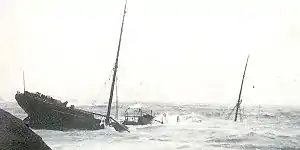SS Maori
SS Maori was a UK refrigerated cargo steamship that was launched in 1893 in England and wrecked in 1909 on the coast of South Africa with the loss of 32 of her crew.
 Maori sinking in 1909 | |
| History | |
|---|---|
| Name: | Maori |
| Namesake: | Māori |
| Owner: | Shaw, Saville & Albion Co |
| Operator: | Shaw, Saville & Albion Co |
| Port of registry: | Southampton |
| Builder: | CS Swan & Hunter, Wallsend |
| Yard number: | 184 |
| Launched: | 14 August 1893 |
| Completed: | October 1893 |
| Identification: | UK official number 104031 |
| Fate: | wrecked 5 August 1909 |
| General characteristics | |
| Type: | refrigerated cargo liner |
| Tonnage: | 5,200 GRT, 4,155 NRT |
| Length: |
|
| Beam: | 48.3 ft (14.7 m) |
| Depth: | 29.6 ft (9.0 m) |
| Decks: | 3 |
| Installed power: | 461 NHP |
| Propulsion: | 3-cylinder triple-expansion engine |
| Speed: | 11 knots (20 km/h) |
| Crew: | 53 |
South Africa's National Heritage Resources Act now protects the wreck. In the right conditions it is a popular scuba wreck diving site.
Building
CS Swan & Hunter built Maori at Wallsend on the River Tyne for Shaw, Saville & Albion Co. Her holds were refrigerated to carry frozen meat from Australasia to the UK. She had four masts, and eight steam winches for handling her cargo. Her hull had a cellular double bottom and was divided by six watertight bulkheads.[1]
Mrs Henderson, with wife of the Rector of St Peter's Church of England parish church, Wallsend, launched her on 14 August 1893. Swan & Hunter completed the ship that October. The Central Marine Engine Works of West Hartlepool built her three-cylinder triple-expansion engine.[1]
Loss
In a storm on 5 August 1909 Maori ran aground a few kilometres south of the suburb of Llandudno on the west coast of Cape Peninsula near Cape Town. Her crew launched three lifeboats, but her Master and 14 of her crew were left aboard ship.[2]
The coast was remote, inaccessible and very rocky and enormous rollers from the Atlantic Ocean crashed against the formidable granite cliffs that overshadowed the stricken vessel. It was late winter and the water was cold. 32 lives were lost, including her Master and most of his navigating officers.[2]
Wreck

The wreck lies in about 30 metres (98 ft) of water between granite boulders. Since the 1960s it has been popular with scuba divers, but it can be visited only when the weather is calm. The hull has been vandalized and much of the general cargo that the ship carried has been removed by hunters of salvage and souvenirs over the years. In the 1970s divers dynamited her hull to search for non-ferrous metal.[2]
The cargo included crockery, rolls of linoleum, champagne and red wine. In the 1970s it was still possible to find bottles of wine scattered about the wreck in the sand. Most of these used to explode when brought to the surface. A few would survive but the wine inside them was impossibly foul.
References
- "Maori". Tyne Built Ships. The Shipping and Shipbuilding Research Trust. Retrieved 30 December 2020.
- Gribble, John. "The Sad Case of the ss Maori". Underwater Cultural Heritage at Risk (PDF). International Council on monuments and sites. pp. 41–43.
